Climate and Permafrost Shifts in Yakutia’s Arctic and Subarctic from 1965 to 2023
Abstract
1. Introduction
2. Materials and Methods
3. Results
3.1. Climate Variability in the Arctic Region of Yakutia over the Past 50–60 Years
3.2. Climate Variability in the Subarctic Region of Yakutia over the Past 50–60 Years
3.3. The Impact of Global Warming on the State of Permafrost
4. Discussion
5. Conclusions
Author Contributions
Funding
Data Availability Statement
Acknowledgments
Conflicts of Interest
References
- Osterkamp, T.E. The recent warming of permafrost in Alaska. Glob. Planet. Chang. 2005, 49, 187–202. [Google Scholar] [CrossRef]
- Pavlov, A.V.; Malkova, G.V. Small-scale mapping of trends of contemporary ground temperature changes in the Russian North. Earth’s Cryosphere 2009, 13, 32–39. (In Russian) [Google Scholar]
- Romanovsky, V.E.; Drozdov, D.S.; Oberman, N.G.; Malkova, G.V.; Kholodov, A.L.; Marchenko, S.S.; Moskalenko, N.G.; Sergeev, D.O.; Ukraintseva, N.G.; Abramov, A.A.; et al. Thermal state of permafrost in Russia. Permafr. Periglac. Process. 2010, 21, 136–155. [Google Scholar] [CrossRef]
- Guo, D.; Sun, J. Permafrost Thaw and Associated Settlement Hazard Onset Timing over the Qinghai-Tibet Engineering Corridor. Int. J. Disaster Risk Sci. 2015, 6, 347–358. [Google Scholar] [CrossRef]
- Biskaborn, B.K.; Smith, S.L.; Noetzli, J.; Matthes, H.; Vieira, G.; Streletskiy, D.A.; Schoeneich, P.; Romanovsky, V.E.; Lewkowicz, A.G.; Abramov, A.; et al. Permafrost is warming at a global scale. Nat. Commun. 2019, 10, 264. [Google Scholar] [CrossRef] [PubMed]
- Etzelmüller, B.; Guglielmin, M.; Hauck, C.; Hilbich, C.; Hoelzle, M.; Isaksen, K.; Noetzli, J.; Oliva, M.; Ramos, M. Twenty years of European mountain permafrost dynamics—The PACE legacy. Environ. Res. Lett. 2020, 15, 104070. [Google Scholar] [CrossRef]
- Hu, G.; Zhao, L.; Wua, T.; Wu, X.; Park, H.; Fedorov, A.; Wei, J.; Li, R.; Zhu, X.; Sun, Z.; et al. Spatiotemporal variations and regional differences in air temperature in the permafrost regions in the Northern Hemisphere during 1980–2018. Sci. Total Environ. 2021, 791, 148358. [Google Scholar] [CrossRef]
- Liljedahl, A.K.; Boike, J.; Daanen, R.P.; Fedorov, A.N.; Frost, G.V.; Grosse, G.; Hinzman, L.D.; Iijima, Y.; Jorgenson, J.C.; Matveyeva, N.; et al. Pan-Arctic ice- wedge degradation in warming permafrost and its influence on tundra hydrology. Nat. Geosci. 2016, 9, 312–318. [Google Scholar] [CrossRef]
- Kokelj, S.; Trevor, C.; Tunnicliffe, J.; Segal, R.; Lacelle, D. Climate-driven thaw of permafrost preserved glacial landscapes, northwestern Canada. Geology 2017, 45, 371–374. [Google Scholar] [CrossRef]
- Nitze, I.; Grosse, G.; Jones, B.M.; Arp, C.D.; Ulrich, M.; Fedorov, A.; Veremeeva, A. Landsat-Based Trend Analysis of Lake Dynamics across Northern Permafrost Regions. Remote Sens. 2017, 9, 640. [Google Scholar] [CrossRef]
- Saito, H.; Iijima, Y.; Basharin, N.I.; Fedorov, A.N.; Kunitsky, V.V. Thermokarst development detected from high-definition topographic data in Central Yakutia. Remote Sens. 2018, 10, 1579. [Google Scholar] [CrossRef]
- Luo, J.; Lin, Z.; Yin, G.; Niu, F.; Liu, M.; Gao, Z.; Fan, X. The ground thermal regime and permafrost warming at two upland, sloping, and undisturbed sites, Kunlun Mountain, Qinghai-Tibet Plateau. Cold Reg. Sci. Technol. 2019, 167, 102862. [Google Scholar] [CrossRef]
- Shiklomanov, N.I.; Streletskiy, D.A.; Swales, T.B.; Kokorev, V.A. Climate Change and Stability of Urban Infrastructure in Russian Permafrost Regions: Prognostic Assessment based on GCM Climate Projections. Geogr. Rev. 2017, 107, 125–142. [Google Scholar] [CrossRef]
- Streletskiy, D.A.; Suter, L.J.; Shiklomanov, N.I.; Porfiriev, B.N.; Eliseev, D.O. Assessment of Climate Change impactson buildings, structures and infrastructurein the Russian regions on permafrost. Environ. Res. Lett. 2019, 14, 025003. [Google Scholar] [CrossRef]
- Streletskiy, D.A.; Clemens, S.; Lanckmanand, J.-P.; Shiklomanov, N.I. The costs of Arctic infrastructure damages due to permafrost degradation. Environ. Res. Lett. 2023, 18, 015006. [Google Scholar] [CrossRef]
- Hjort, J.; Karjalainen, O.; Aalto, J.; Westermann, S.; Romanovsky, V.E.; Nelson, F.E.; Etzelmüller, B.; Luoto, M. Degrading permafrost puts Arctic infrastructure at risk by mid-century. Nat. Commun. 2018, 9, 5147. [Google Scholar] [CrossRef]
- Hjort, J.; Streletskiy, D.; Doré, G.; Wu, Q.; Bjella, K.; Luoto, M. Impacts of permafrost degradationon infrastructure. Nat. Rev. Earth Environ. 2022, 3, 24–38. [Google Scholar] [CrossRef]
- Skachkov, Y.B. Climatic variability in Yakutia at the turn of the 20th and 21th centuries. In Proceedings of the Fourth Conference of Geocryologists of Russia, Moscow, Russia, 7–9 June 2011; Publishing House Moscow state University: Moscow, Russia, 2011; Volume 2, Part 6, pp. 312–318. (In Russian). [Google Scholar]
- Gorokhov, A.N.; Fedorov, A.N. Current Trends in Climate Change in Yakutia. Geogr. Nat. Resour. 2018, 39, 153–161. [Google Scholar] [CrossRef]
- Boike, J.; Juszak, J.; Lange, S.; Chadburn, S.; Burke, E.; Overduin, P.; Roth, K.; Ippisch, O.; Bornemann, N.; Stern, L.; et al. A 20-year record (1998–2017) of permafrost, active layer and meteorological conditions at a high Arctic permafrost research site (Bayelva, Spitsbergen). Earth Syst. Sci. Data 2018, 10, 355–390. [Google Scholar] [CrossRef]
- Fyodorov-Davydov, D.G.; Kholodov, A.L.; Ostroumov, V.E.; Kraev, G.N.; Sorokovikov, V.A.; Kholodov, S.; Merekalova, A.A. Seasonal Thaw of Soils in the North Yakutian Ecosystems. In Proceedings of the 9th International Conference on Permafrost. Institute of Northern Engineering, Fairbanks, Alaska, 29 June–3 July 2008; Volume 2, pp. 481–486. [Google Scholar]
- Kholodov, A.; Gilichinsky, D.; Ostroumov, V.; Sorokovikov, V.; Abramov, A.; Davydov, S.; Romanovsky, V. Regional and Local Variability of Modern Natural Changes in Permafrost Temperature in the Yakutia Coastal Lowlands, Northeastern Siberia. In Proceedings of the Tenth International Conference of Permafrost, Salehard, Russia, 25–29 June 2012; Volume 1, pp. 203–208. [Google Scholar]
- Kunitsky, V.V.; Syromyatnikov, I.; Schirrmeister, L.; Skachov, Y.B.; Grosse, G.; Wetterich, S.; Grigoriev, M.N. Ice-rich permafrost and thermal denudation in the Batagay area (Yana Upland, East Siberia). Earths Cryosphere 2013, 17, 56–58. (In Russian) [Google Scholar]
- Desyatkin, R.; Okoneshnikova, M.; Ivanova, A.; Nikolaeva, M.; Filippov, N.; Desyatkin, A. Dynamics of Vegetation and Soil Cover of Pyrogenically Disturbed Areas of the Northern Taiga under Conditions of Thermokarst Development and Climate Warming. Land 2022, 11, 1594. [Google Scholar] [CrossRef]
- Murton, J.; Opel, T.; Wetterich, S.; Ashastina, K.; Savvinov, G.; Danilov, P.; Boeskorov, V. Batagay megaslump: A review of the permafrost deposits, Quaternary environmental history, and recent development. Permafr. Periglac Process. 2023, 34, 399–416. [Google Scholar] [CrossRef]
- Litzow, M.A. Climate regime shifts and community reorganization in the Gulf of Alaska: How do recent shifts compare with 1976/1977? ICES J. Mar. Sci. 2006, 63, 1386–1396. [Google Scholar] [CrossRef]
- Thompson, D.W.J.; Wallage, J.M.; Jones, P.D.; Kennedy, J.J. Identifying Signatures of Natural Climate Variability in Time Series of Global-Mean Surface Temperature: Methodology and Insights. J. Clim. 2009, 22, 6120–6141. [Google Scholar] [CrossRef]
- Thompson, D.W.J.; Wallage, J.M.; Kennedy, J.J.; Jones, P.D. An abrupt drop in Northern Hemisphere sea surface temperature around 1970. Nature 2010, 467, 444–447. [Google Scholar] [CrossRef]
- Lobanov, V.A. Textbook on Regional Climatology, Training ed.; RSHU: St. Petersburg, Russia, 2020; 60p. [Google Scholar]
- Fedorov, A.N.; Ivanova, R.N.; Park, H.; Hiyama, T.; Iijima, Y. Recent air temperature changes in the permafrost landscapes of northeastern Eurasia. Polar Sci. 2014, 8, 114–128. [Google Scholar] [CrossRef]
- Romanovsky, V.E.; Sazonova, T.S.; Balobaev, V.T.; Shender, N.I.; Sergueev, D.O. Past and recent changes in air and permafrost temperatures in eastern Siberia. Glob. Planet. Chang. 2007, 56, 399–413. [Google Scholar] [CrossRef]
- Romanovsky, V.E.; Smith, S.L.; Christiansen, H.H. Permafrost thermal state in the polar Northern Hemisphere during the international polar year 2007–2009: A synthesis. Permafr. Periglac Process. 2010, 21, 106–116. [Google Scholar] [CrossRef]
- Vasiliev, A.A.; Streletskaya, I.D.; Shirokov, R.S.; Oblogov, G.E. Coastal permafrost evolution of Western Yamal in context of climate change. Earths Cryosphere 2011, 2, 56–64. (In Russian) [Google Scholar]
- Vasiliev, A.A.; Drozdov, D.S.; Gravis, A.; Malkova, G.; Nyland, K.E.; Streletskiy, D.A. Permafrost degradation in the Western Russian Arctic. Environ. Res. Lett. 2020, 10, 045001. [Google Scholar] [CrossRef]
- Kraev, G.; Abramov, A.; Bykhovets, S.; Fyodorov-Davydov, D.; Kholodov, A.; Lupachev, A.; Mamykin, V.; Ostroumov, V.; Sorokovikov, V.; Gilichinsky, D.; et al. Thermal State of Permafrost in the Eastern Arctic. In Tenth International Conference on Permafrost; Kane, D.L., Hinkel, K.M., Eds.; Institute of Northern Engineering, University of Alaska Fairbanks: Fairbanks, AK, USA, 2012; Volume 1, pp. 993–998. [Google Scholar]
- Konstantinov, P.; Basharin, N.; Fedorov, A.; Iijima, Y.; Andreeva, V.; Semenov, V.; Vasiliev, N. Impact of Climate Change on the Ground Thermal Regime in the Lower Lena Region, Arctic Central Siberia. Land 2023, 12, 19. [Google Scholar] [CrossRef]
- Fyodorov-Davydov, D.G.; Davydov, S.P.; Davydova, A.I.; Shmelev, D.G.; Ostroymov, V.E.; Kholodov, A.L.; Sorokovikov, V.A. The thermal state of soils in northern Yakutia. Earths Cryosphere 2018, 22, 47–58. [Google Scholar]
- Ostroymov, V.E.; Fedoryov-Davydov, D.G.; Kholodov, A.L.; Davydov, S.P.; Davydova, A.I.; Sorokovikov, V.A. Thermal regime of soils and permafrost subsoil of northern Yakutia in connection with global climate change. In Proceedings of the VIII Congress of the V.V. Dokuchaev Soil Science Society, Part 3, FRC Komi RC UB RAS, Syktyvkar, Russia, 19–24 July 2021; pp. 995–997. (In Russian). [Google Scholar]
- Andreeva, V.V.; Maksimov, G.T.; Spektor, V.V.; Kholodov, A.L.; Davydov, S.P. Temperature regime of permafrost in post-pyrogenic areas of the northern Kolyma lowland. Adv. Mod. Nat. Sci. 2021, 8, 29–40. (In Russian) [Google Scholar]
- Abramov, A.; Davydov, S.; Ivashchenko, A.; Karelin, D.; Kholodov, A.; Kraev, G.; Lupachev, A.; Maslakov, A.; Ostroumov, V.; Rivkina, E.; et al. Two decades of active layer thickness monitoring in northeastern Asia. Polar Geogr. 2019, 44, 186–202. [Google Scholar] [CrossRef]
- Bekryaev, R.V.; Polyakov, I.V.; Alexeev, V.A. Role of Polar Amplification in Long-Term Surface Air Temperature Variations and Modern Arctic Warming. J. Clim. 2010, 23, 3888–3906. [Google Scholar] [CrossRef]
- Jones, B.M.; Grosse, G.D.A.C.; Jones, M.C.; Walter Anthony, K.M.; Romanovsky, V.E. Modern thermokarst lake dynamics in the continuous permafrost zone, northern Seward Peninsula, Alaska. J. Geophys. Res.–Biogeo 2011, 116, G00M03. [Google Scholar] [CrossRef]
- Jones, B.; Grosse, G.; Arp, C.; Miller, E.; Liu, L.; Hayes, D.; Larsen, C. Recent Arctic tundra fire initiates widespread thermokarst development. Sci. Rep. 2015, 5, 15865. [Google Scholar] [CrossRef]
- Morgenstern, A.; Ulrich, M.; Günther, F.; Roessler, S.; Fedorova, I.V.; Rudaya, N.A.; Wetterich, S.; Boike, J.; Schirrmeister, L. Evolution of thermokarst in East Siberian ice-rich permafrost: A case study. Geomorphology 2013, 201, 363–379. [Google Scholar] [CrossRef]
- Niu, F.; Cheng, G.; Luo, J.; Jin, Z. Advances thermokarst lake research in permafrost regions. Sci. Cold Arid Reg. 2014, 6, 388–397. [Google Scholar]
- Luo, J.; Niu, F.; Lin, Z.; Liu, M.; Yin, G. Thermokarst lake changes between 1969 and 2010 in the Beilu River Basin, Qinghai–Tibet Plateau, China. Sci. Bull. 2015, 60, 556–564. [Google Scholar] [CrossRef]
- Farquharson, L.M.; Romanovsky, V.E.; Cable, W.L.; Walker, D.A.; Kokelj, S.V.; Nicolsky, D. Climate change drives widespread and rapid thermokarst development in very cold permafrost in the Canadian High Arctic. Geophys. Res. Lett. 2019, 46, 6681–6689. [Google Scholar] [CrossRef]
- Guglielmin, M.; Ponti, S.; Forte, E.; Cannone, N. Recent thermokarst evolution in the Italian Central Alps. Permafr. Periglac Process. 2021, 32, 299–317. [Google Scholar] [CrossRef]
- Malkova, G.; Drozdov, D.; Vasiliev, A.; Gravis, A.; Kraev, G.; Korostelev, Y.; Nikitin, K.; Orekhov, P.; Ponomareva, O.; Romanovsky, V.; et al. Spatial and Temporal Variability of Permafrost in the Western Part of the Russian Arctic. Energies 2022, 15, 2311. [Google Scholar] [CrossRef]
- Guo, D.; Wang, H. The significant climate warming in the northern Tibetan Plateau and its possible causes. Int. J. Climatol. 2011, 32, 1775–1781. [Google Scholar] [CrossRef]
- Hu, G.; Zhao, L.; Wu, T.; Wu, X.; Park, H.; Li, R.; Zhu, X.; Ni, J.; Zou, D.; Hao, J.; et al. Continued warming of the permafrost regions over the Northern Hemisphere under future climate change. Earth’s Future 2022, 10, e2022EF002835. [Google Scholar] [CrossRef]
- Tyrtikov, A.P. The Influence of Vegetation on Freezing and Thawing of Soils; Publishing House of Moscow State University: Moscow, Russia, 1969; 192p. (In Russian) [Google Scholar]
- Tyrtikov, A.P. Dynamics of Vegetation Cover and Development of Permafrost Landforms; Nauka: Moscow, Russia, 1979; 116p. (In Russian) [Google Scholar]
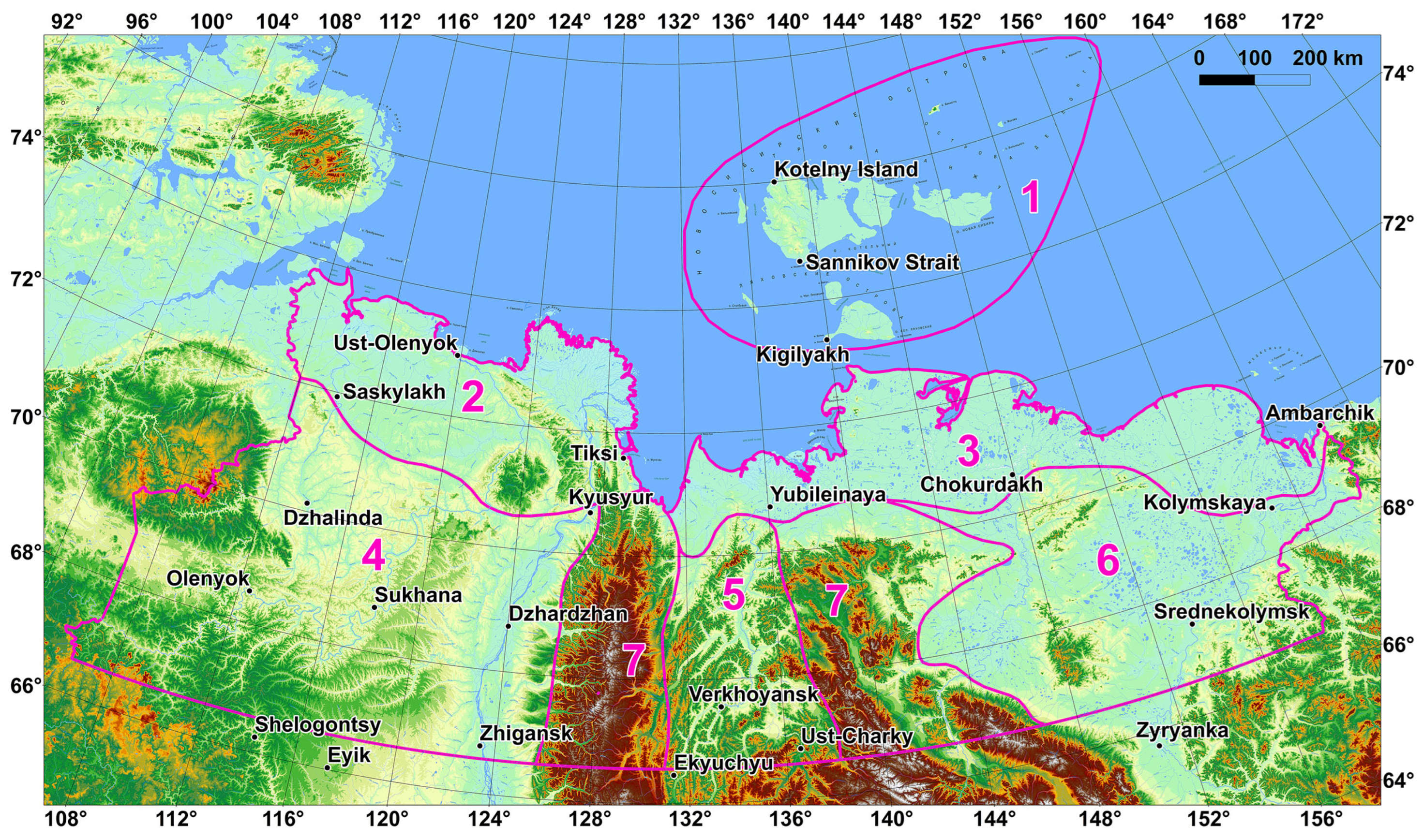
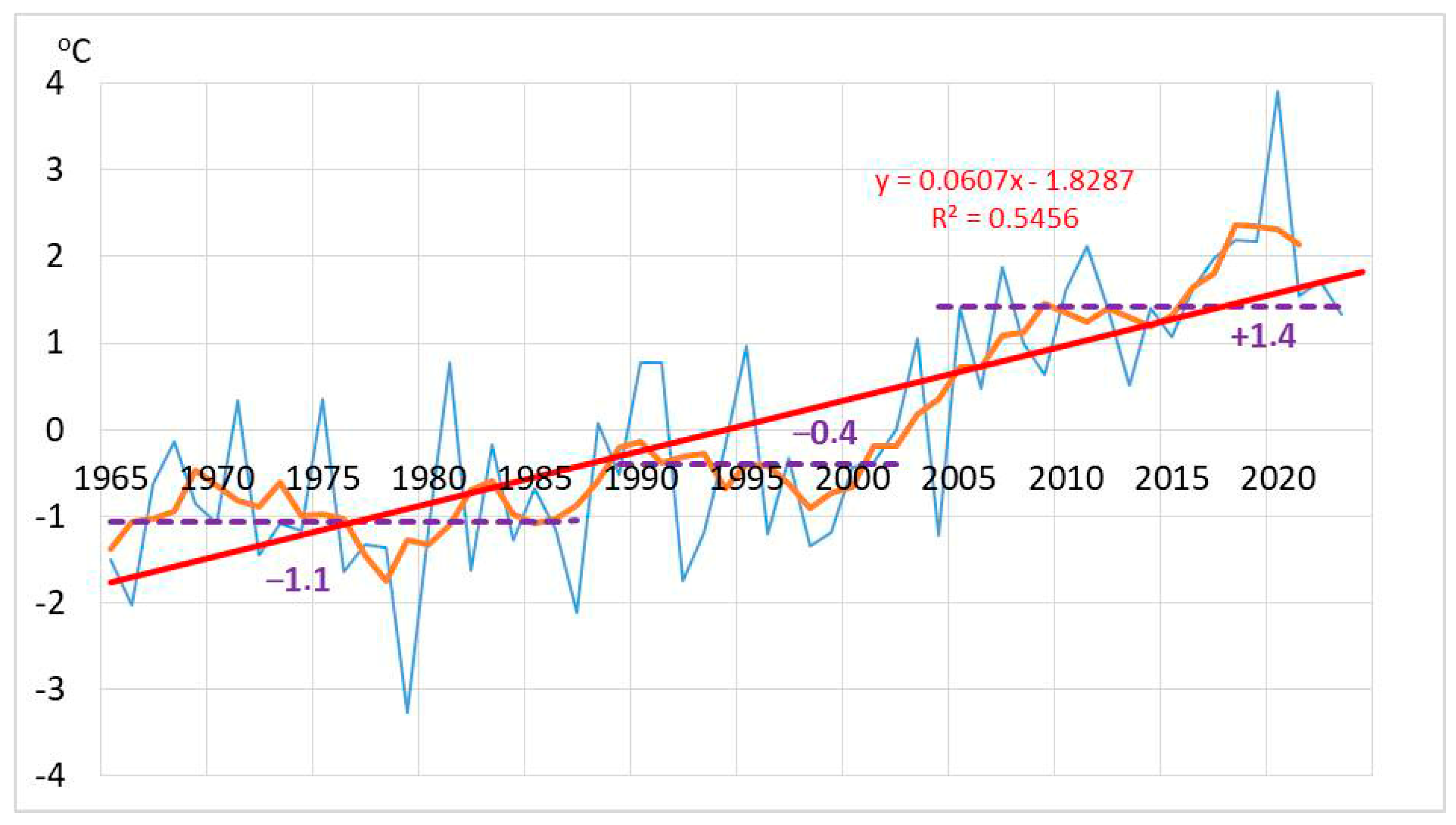

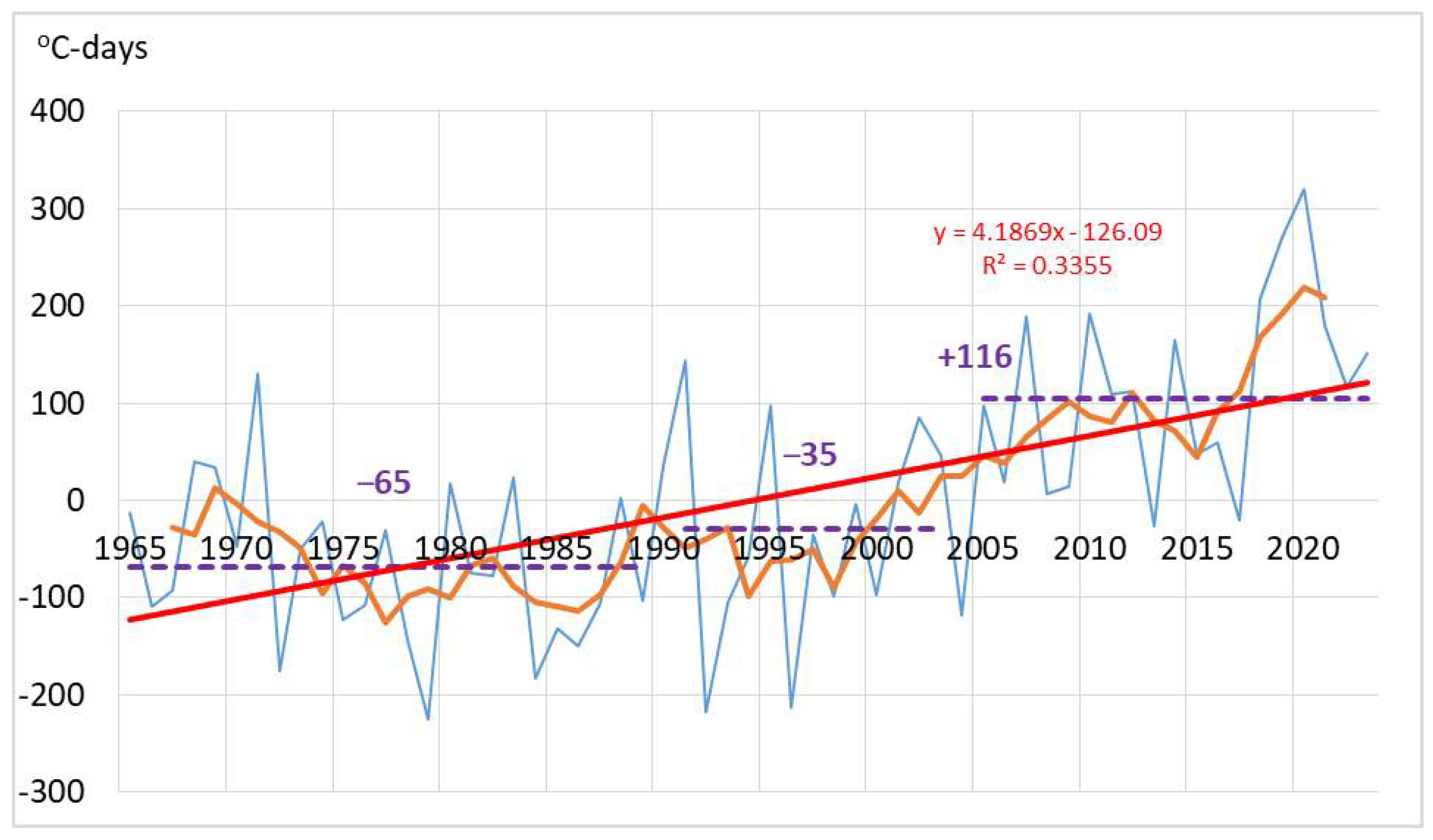

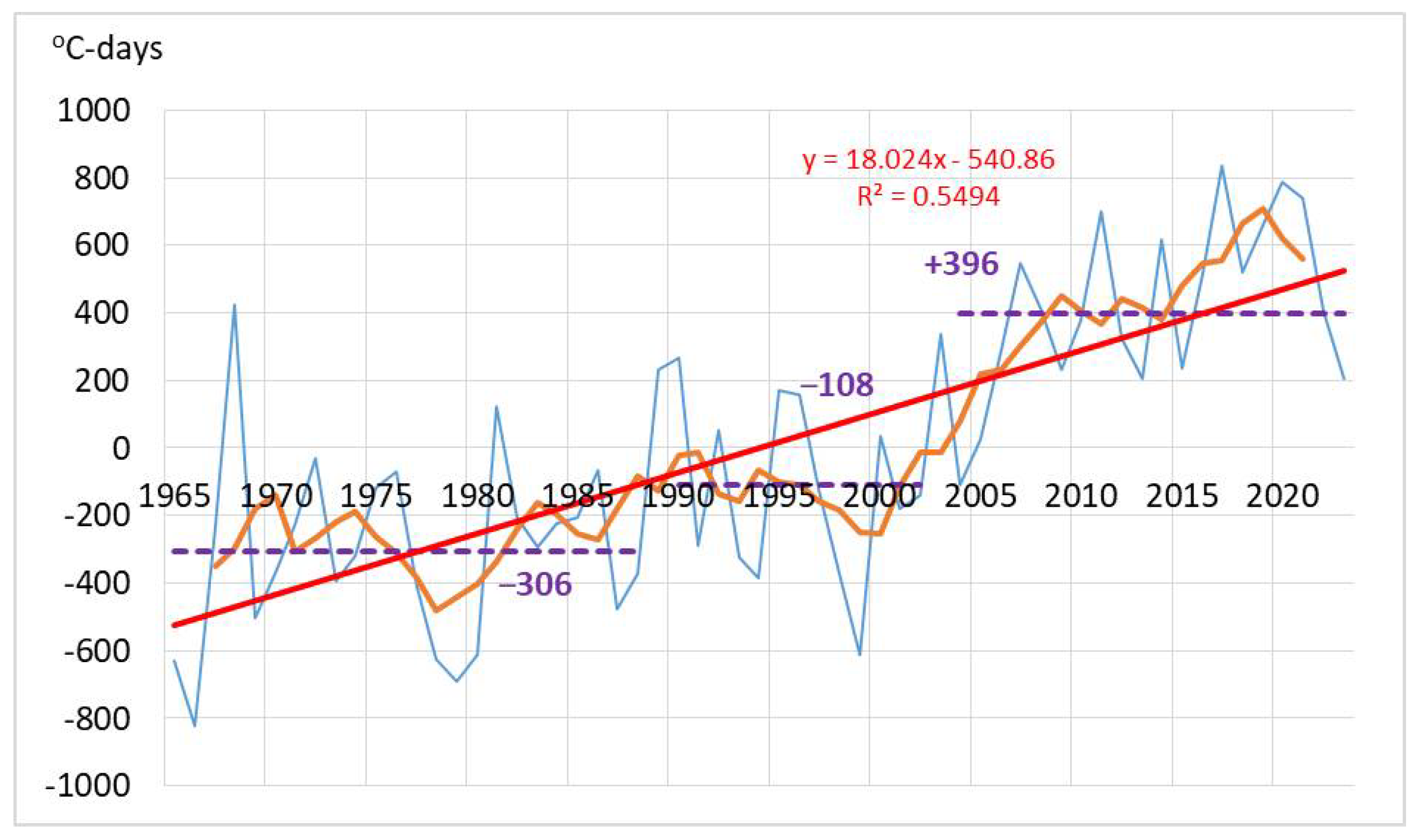
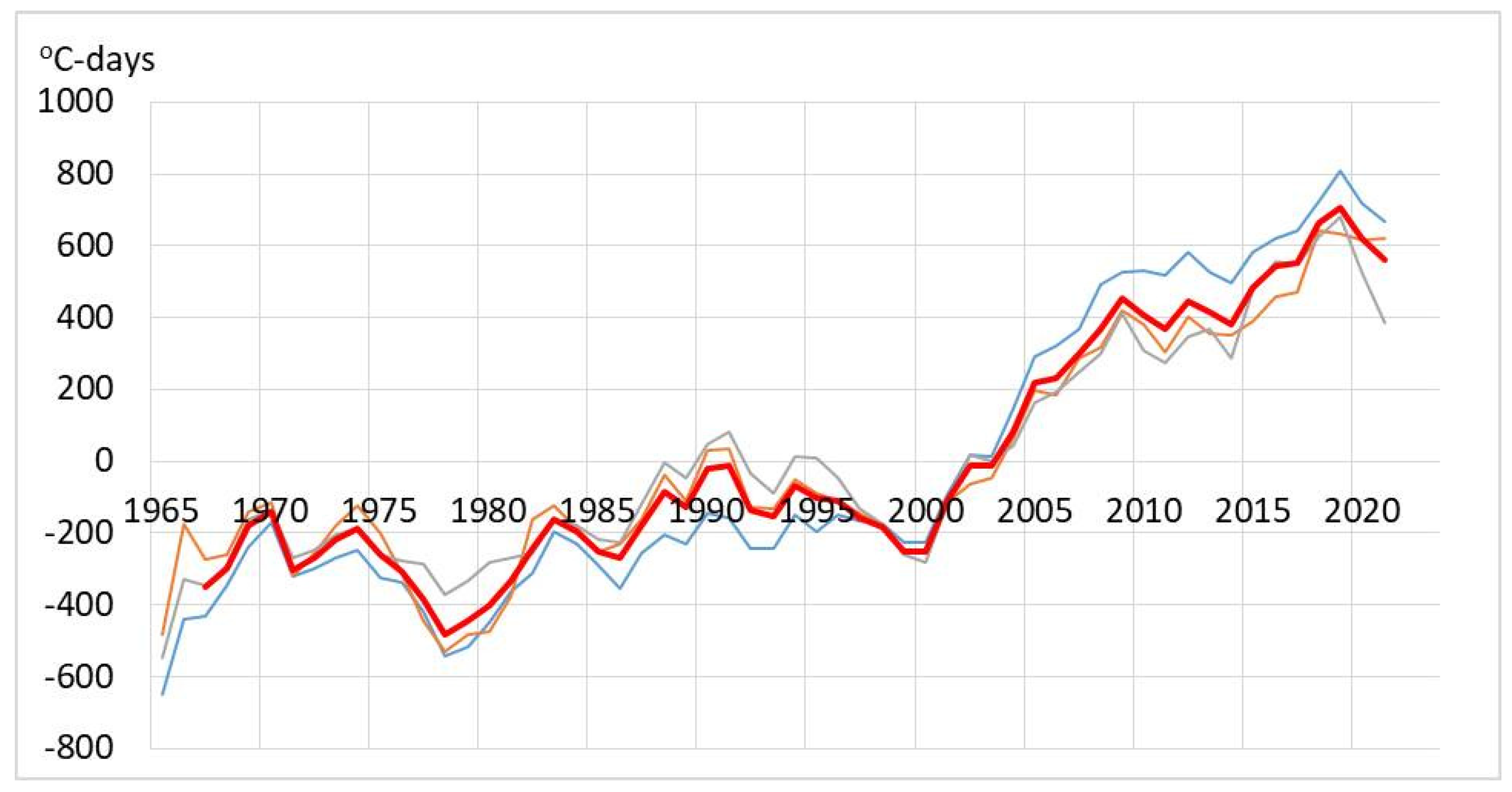
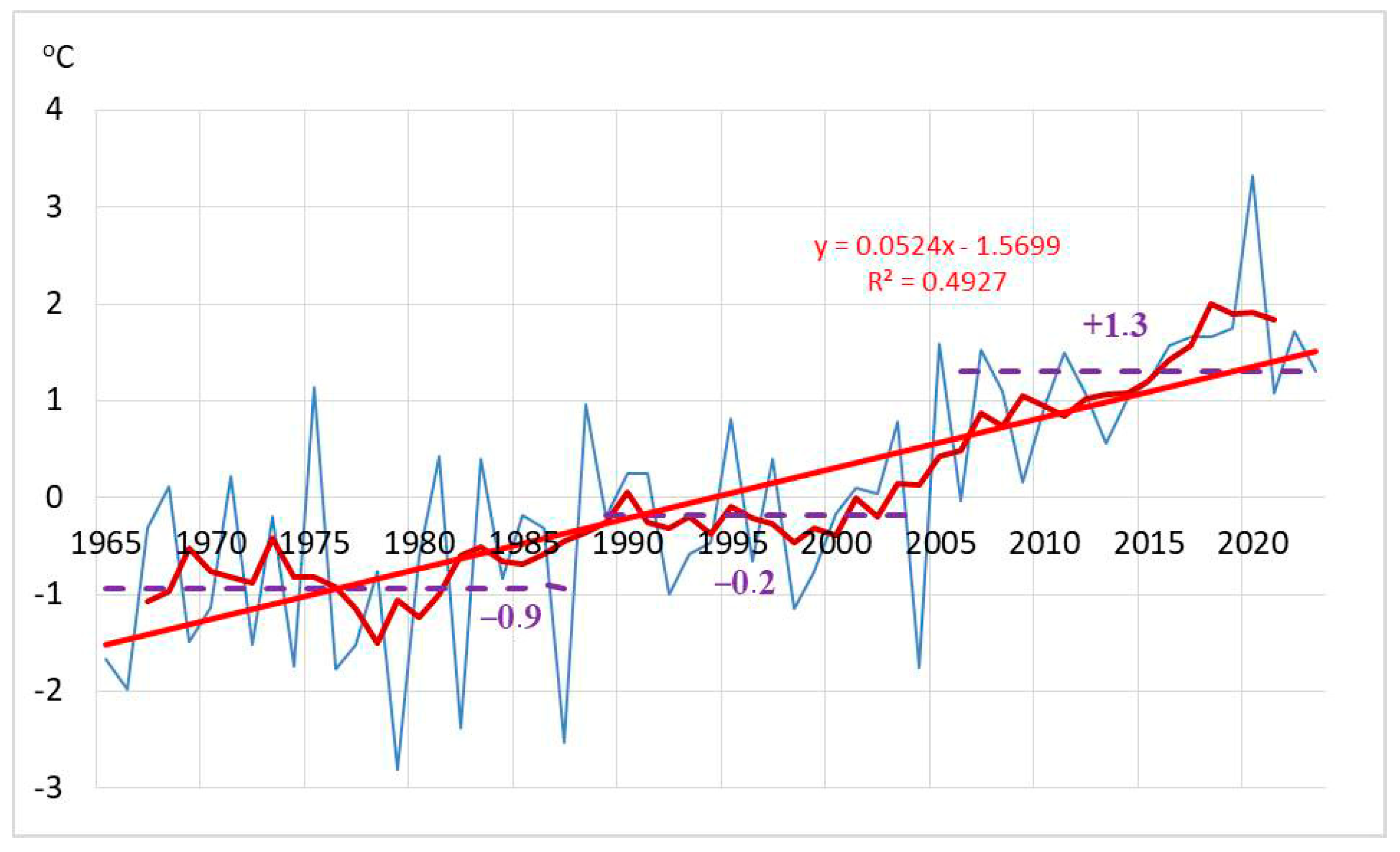
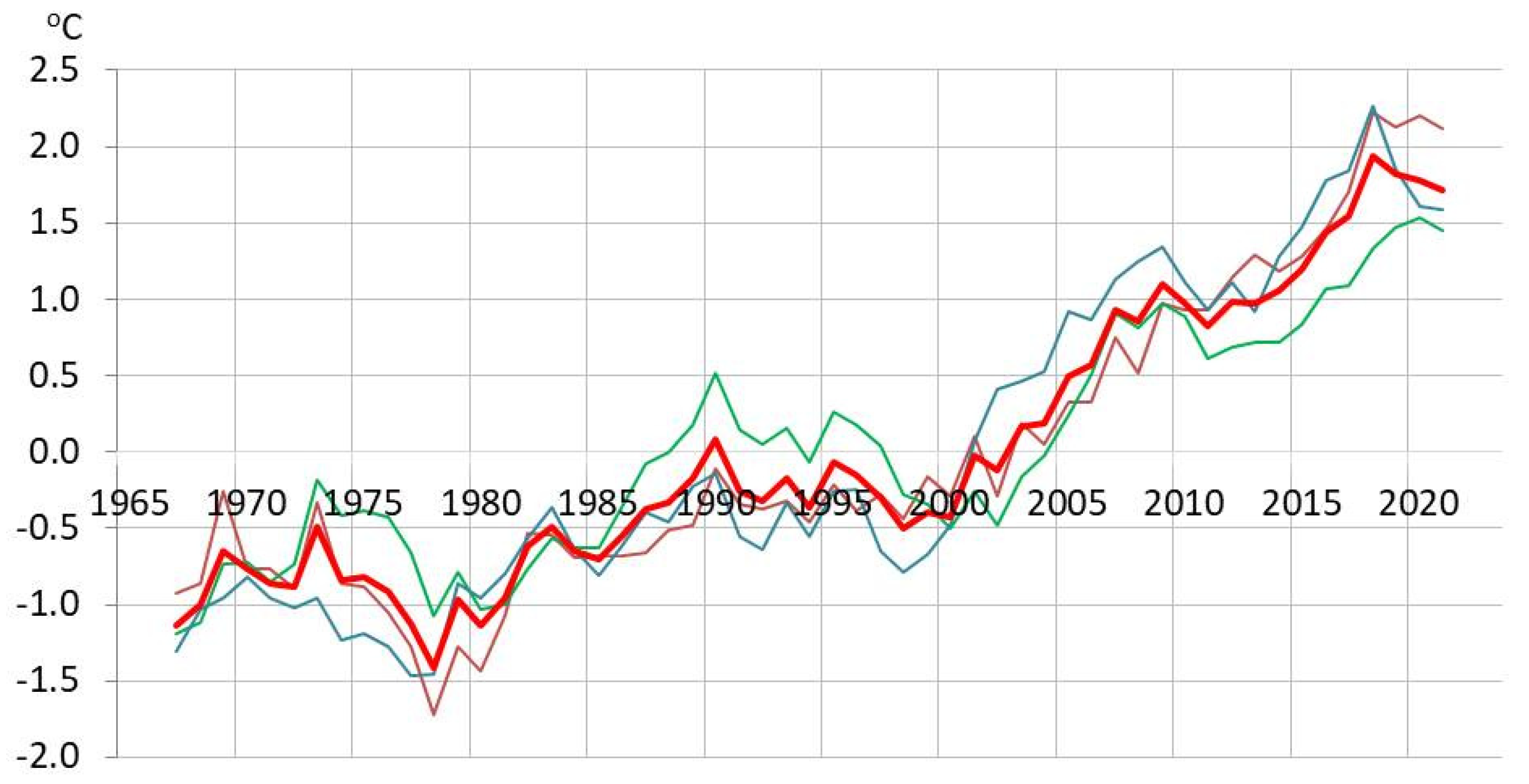

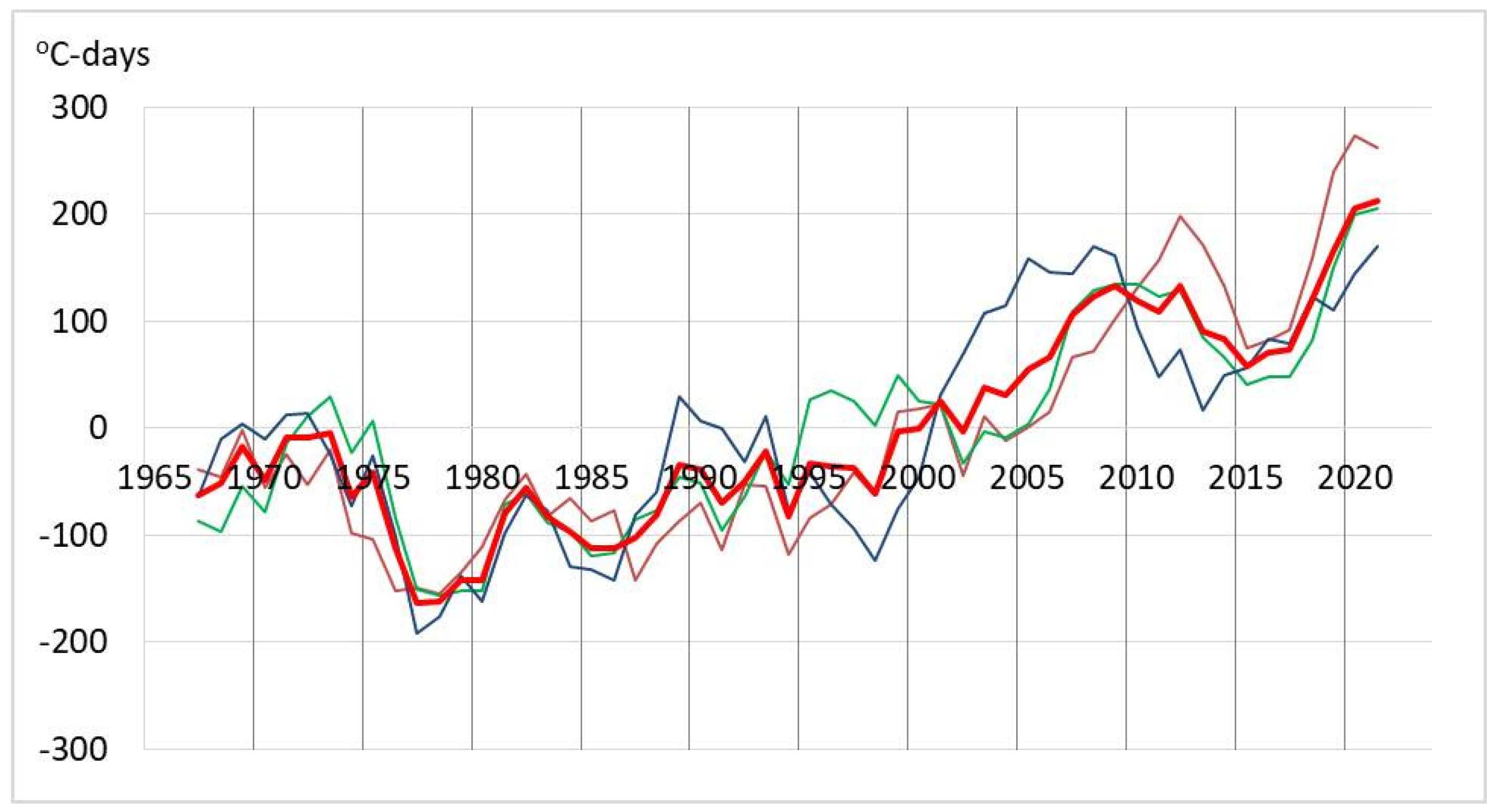
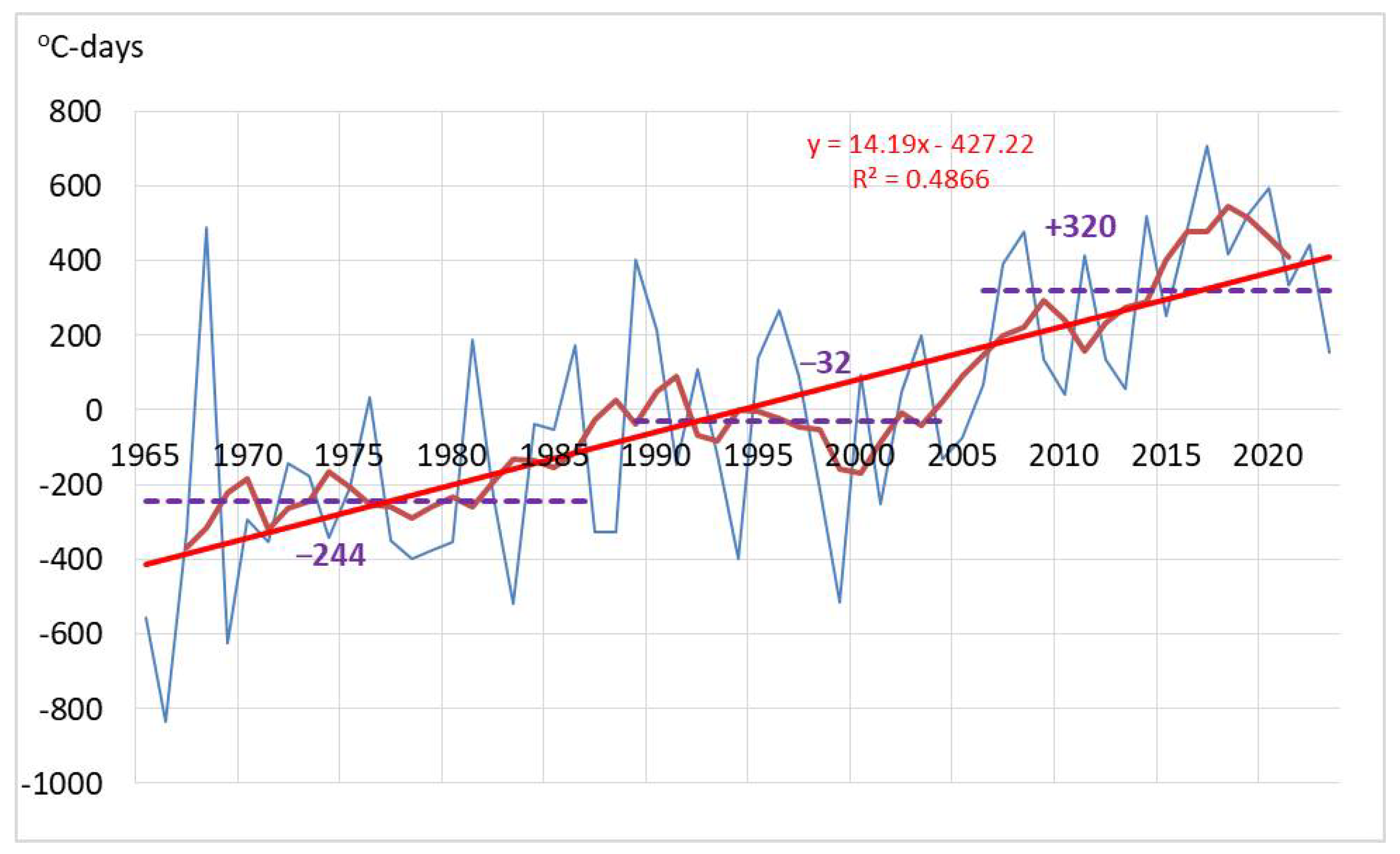
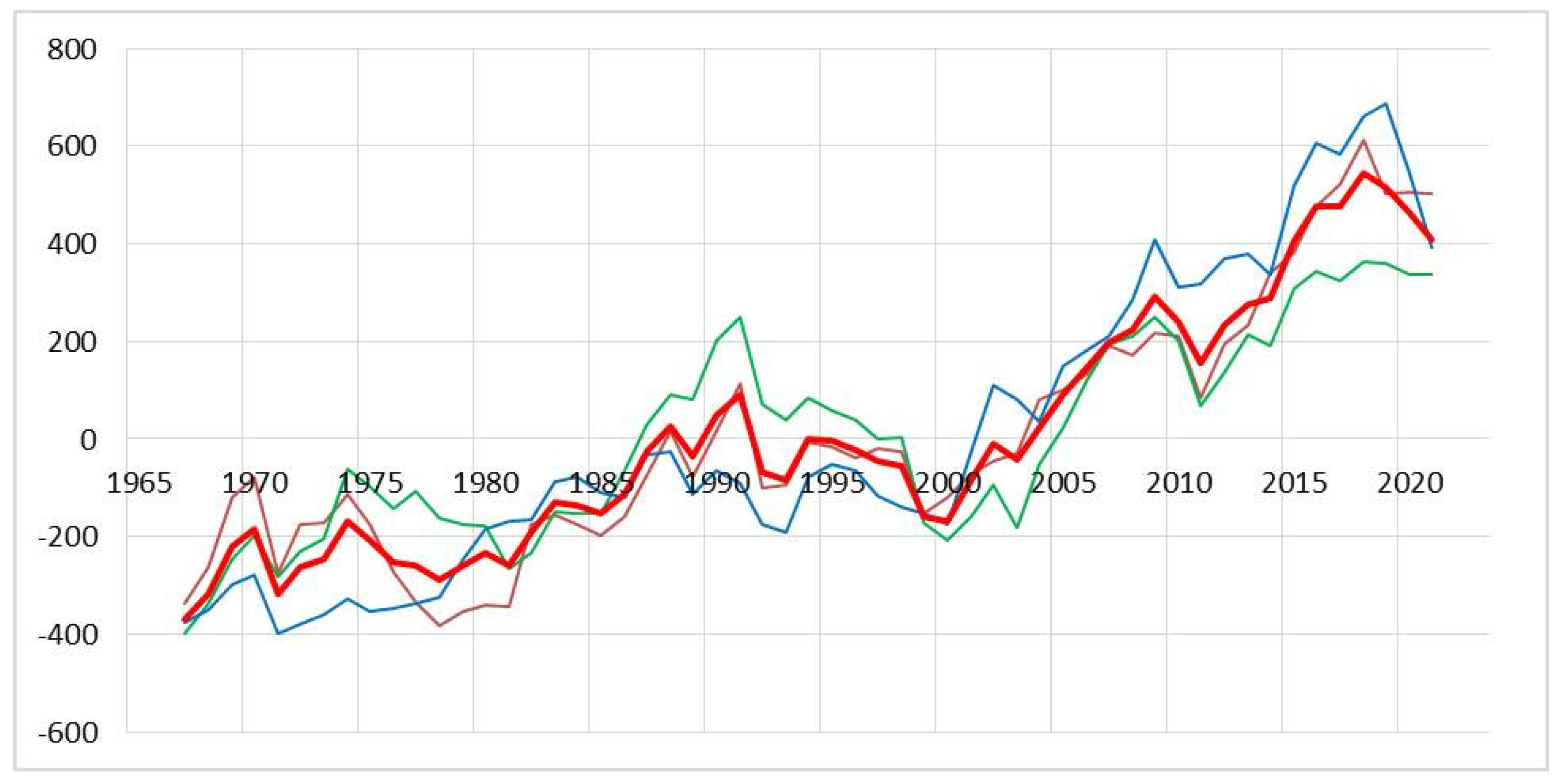
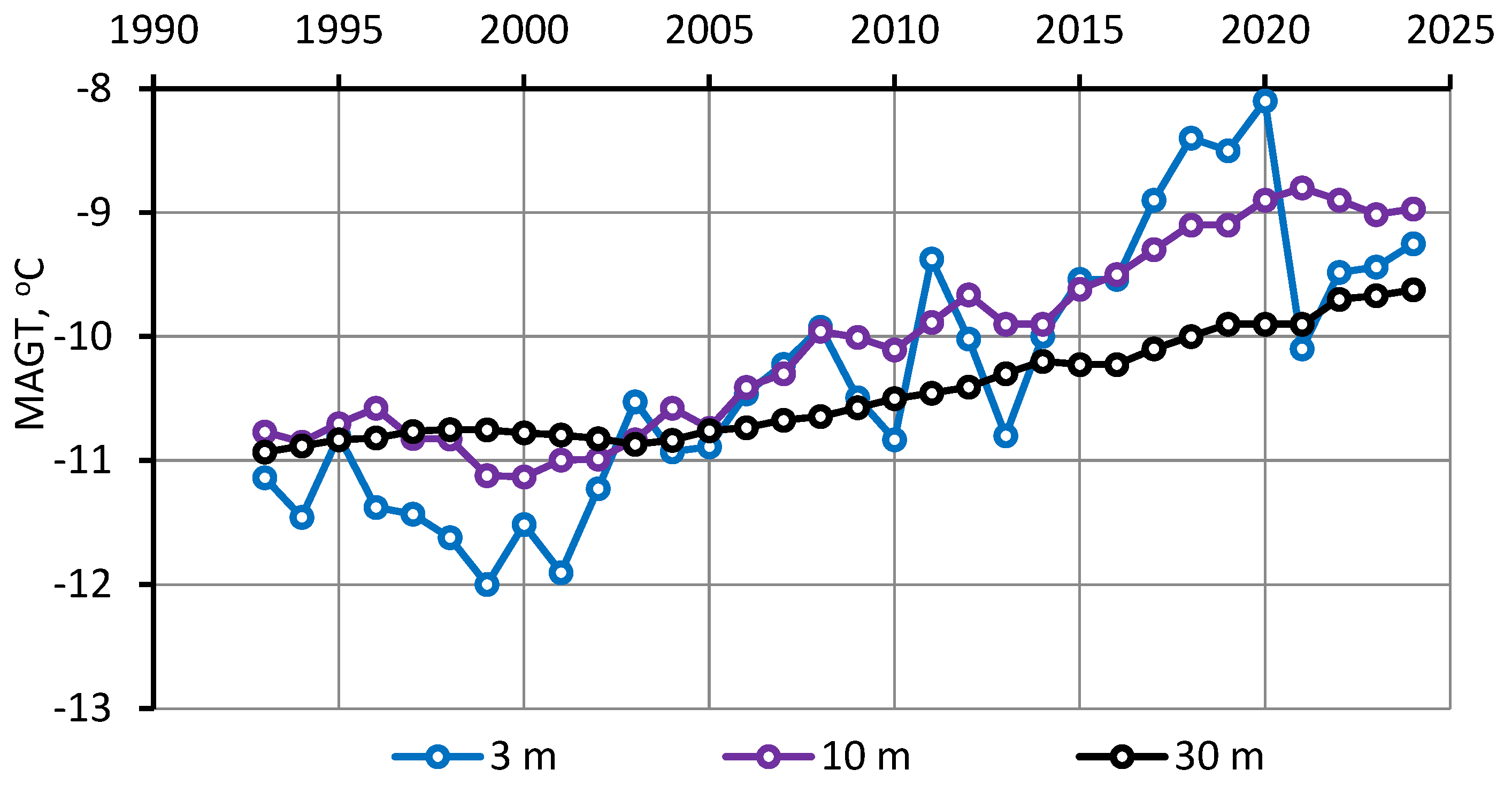
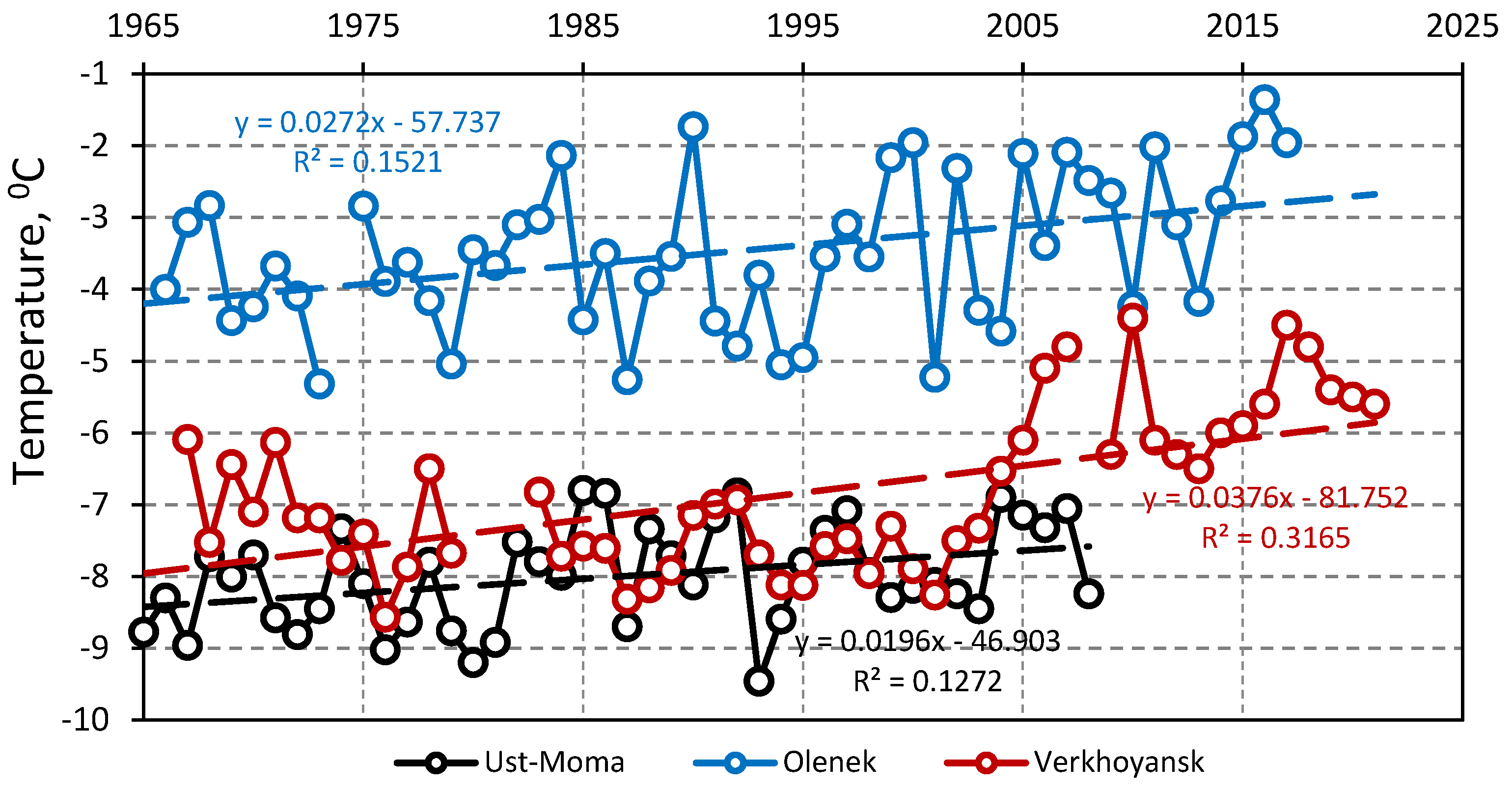
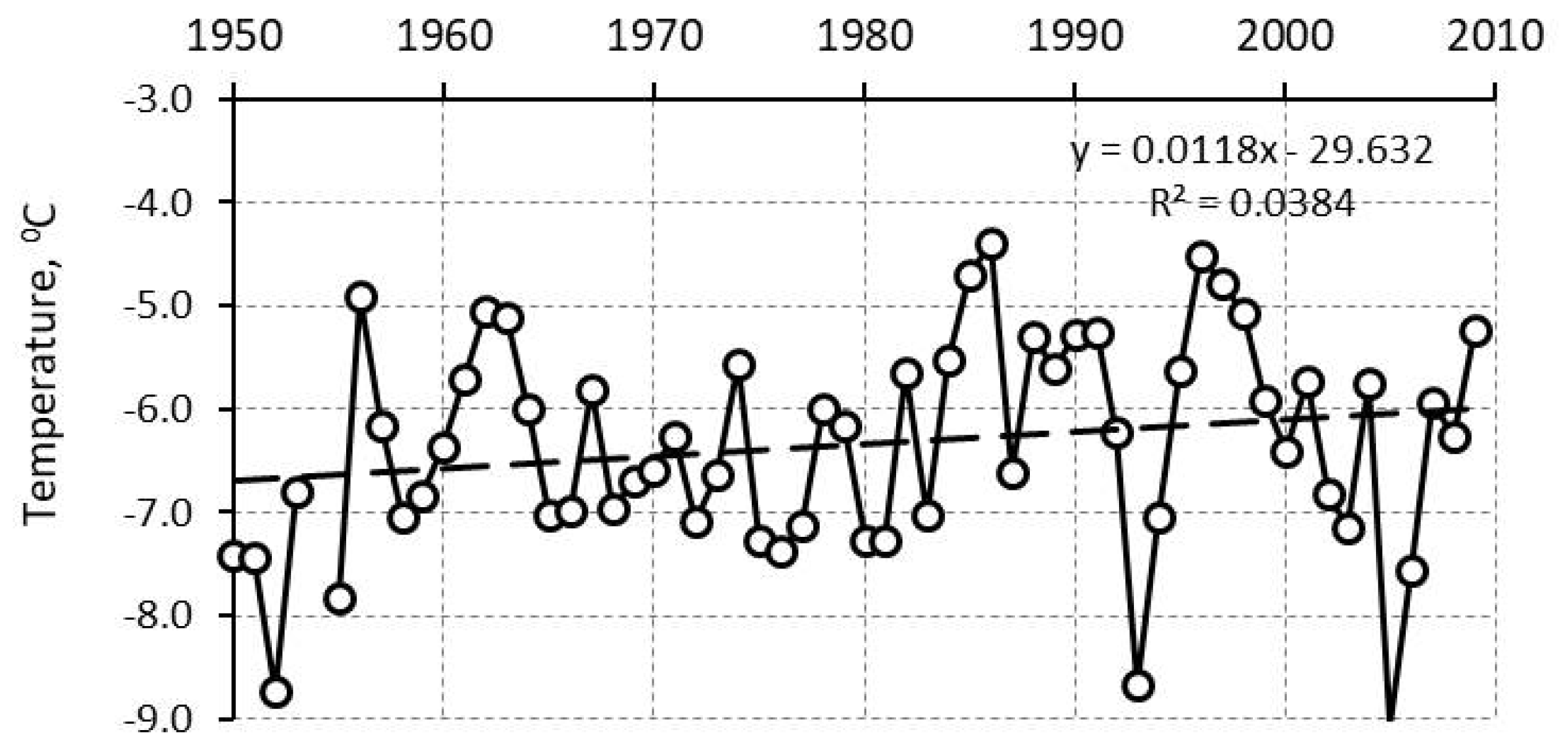
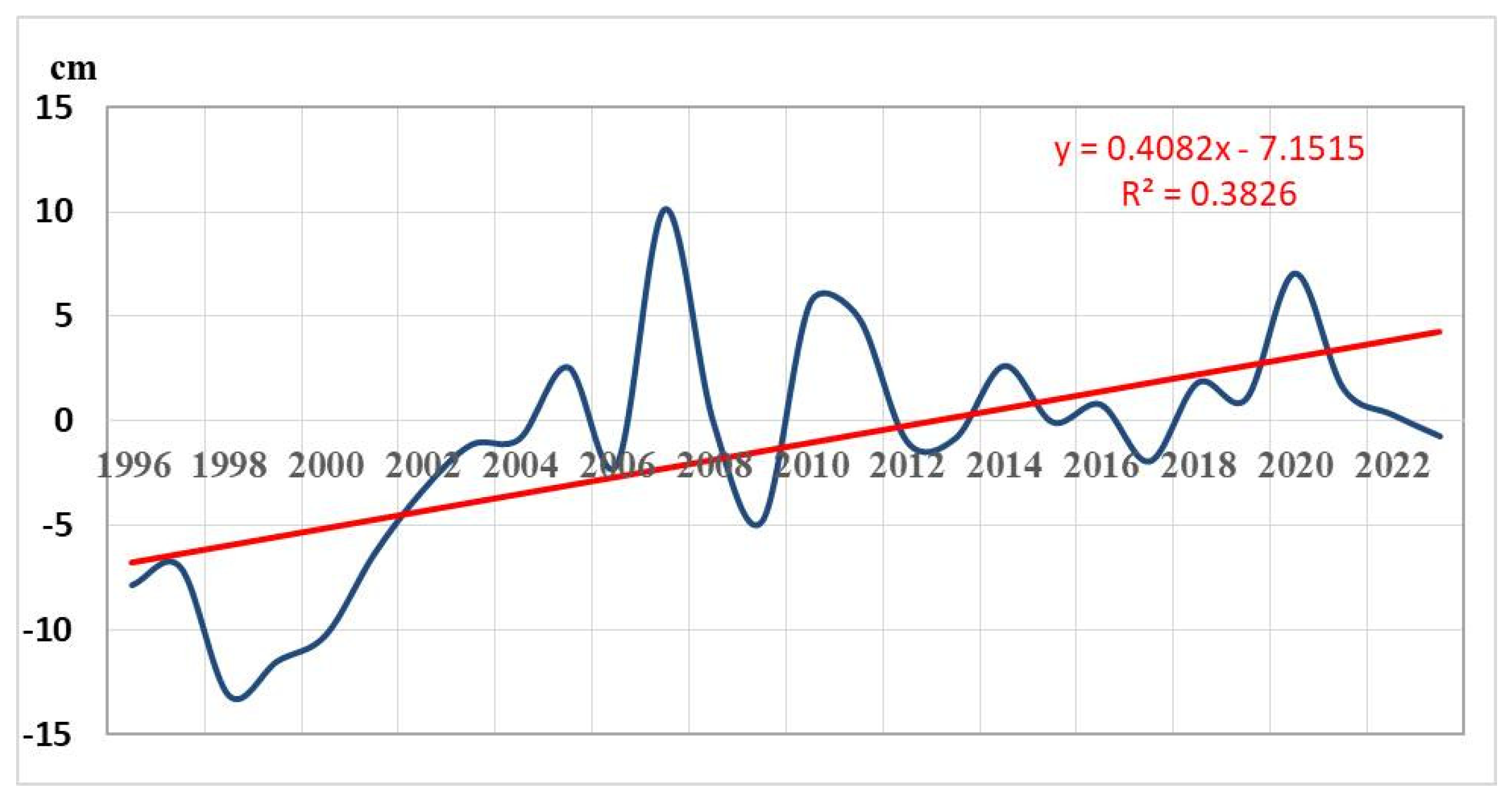


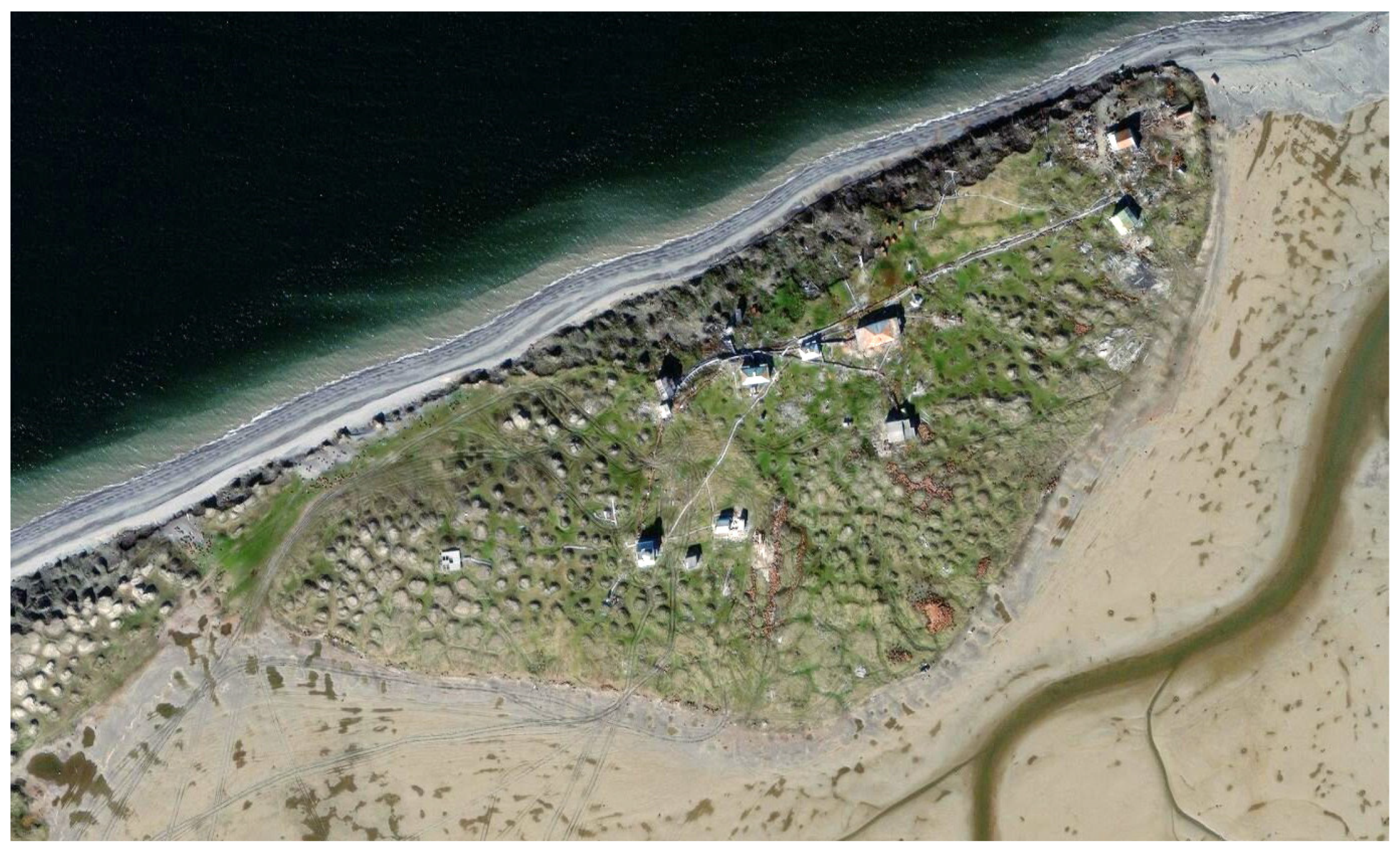
| Region | Weather Station | Latitude, Longitude | ASL, m. | Air Temperature | Precipitation |
|---|---|---|---|---|---|
| New Siberian | Kotelny Island | 76°00′, 137°52′ | 12 | 1965–2023 | 1966–2023 |
| Islands | Sannikov Strait | 74°40′, 138°54′ | 16 | 1965–2023 | 1983–1990, 2011–2023 |
| Kigilyakh | 73°20′, 139°52′ | 26 | 1965–2023 | 1966–1992, 2001–2003, 2005–2023 | |
| Lena–Anabar | Saskylakh | 71°58′, 114°05′ | 16 | 1965–2023 | 1966–2023 |
| Ust-Olenek | 73°00′, 119°52′ | 16 | 1965–2023 | 1973–1981, 1983–1990, 2008–2018 | |
| Tiksi | 71°35′, 128°55′ | 6 | 1965–2023 | 1966–2023 | |
| Lena–Olenyok | Dzhalinda | 70°08′, 113°58′ | 61 | 1965–2023 | 1966–2023 |
| Olenyok | 68°31′, 112°29′ | 195 | 1965–2023 | 1966–2023 | |
| Kyusyur | 70°41′, 127°24′ | 30 | 1965–2023 | 1966–2023 | |
| Sukhana | 68°37′, 118°20′ | 78 | 1965–2023 | 1966–2023 | |
| Shelagontsy | 66°15′, 114°17′ | 233 | 1965–2023 | 1966–2023 | |
| Eyik | 66°02′, 117°24′ | 304 | 1965–2023 | 1966–2023 | |
| Dzhardzhan | 68°44′, 124°00′ | 38 | 1965–2023 | 1966–2023 | |
| Zhigansk | 66°46′, 123°24′ | 88 | 1965–2023 | 1966–2023 | |
| Yana | Verkhoyansk | 67°34′, 133°24′ | 136 | 1965–2023 | 1966–2023 |
| Ekyuchyu | 66°34′, 131°36′ | 199 | 1965–2023 | 2011–2023 | |
| Ust-Charky | 66°48′, 136°41′ | 274 | 1965–2023 | 1966–2023 | |
| Iema | 65°18′, 135°48′ | 675 | 1965–2023 | 1966–1974, 1977–1992, 1914–2023 | |
| Yana | Sredne-kolymsk | 67°27′, 153°43′ | 20 | 1965–2023 | 1966–2023 |
| Zyryanka | 65°44′, 150°54′ | 41 | 1965–2023 | 1966–2023 | |
| Kolymskaya | 68°44′, 158°43′ | 9 | 1965–2023 | 1973–1981, 2007–2023 |
| Region | Weather Station | Mean for 1965–2023 | Mean for 1965–1987 | Mean for 1988–2004 | Mean for 2005–2023 |
|---|---|---|---|---|---|
| New Siberian | Kotelny Island | −14.0 ± 1.6 | −15.1 ± 0.9 | −14.6 ± 1.1 | −12.1 ± 0.9 |
| Islands | Sannikov Strait | −14.4 ± 1.5 | −15.6 ± 0.9 | −14.8 ± 1.1 | −12.7 ± 0.8 |
| Kigilyakh | −13.8 ± 1.4 | −14.9 ± 0.9 | −14.0 ± 1.0 | −12.2 ± 0.7 | |
| Lena–Anabar | Saskylakh | −13.8 ± 1.7 | −14.8 ± 1.4 | −14.3 ± 1.0 | −12.1 ± 1.2 |
| Ust-Olenek | −13.5 ± 1.6 | −14.6 ± 1.1 | −14.0 ± 1.3 | −11.8 ± 1.1 | |
| Tiksi | −12.5 ± 1.7 | −13.5 ± 1.3 | −12.8 ± 1.3 | −11.1 ± 1.0 | |
| Yana–Kolyma | Yubileinaya | −13.1 ± 1.4 | −14.0 ± 1.2 | −13.1 ± 1.4 | −11.9 ± 0.9 |
| Chokurdakh | −13.3 ± 1.3 | −14.3 ± 0.8 | −13.5 ± 1.0 | −11.8 ± 0.8 | |
| Ambarchik | −11.8 ± 1.5 | −12.9 ± 0.8 | −12.4 ± 1.2 | −10.3 ± 1.1 |
| Region | Weather Station | Mean for 1965–2023 | Mean for 1965–1987 | Mean for 1988–2004 | Mean for 2005–2023 |
|---|---|---|---|---|---|
| New Siberian Islands * | Kotelny Island | 198 ± 119 | 145 ± 181 | 161 ± 106 | 294 ± 117 |
| Kigilyakh | 256 ± 124 | 80 ± 91 | 106 ± 116 | 239 ± 102 | |
| Lena–Anabar | Saskylakh | 858 ± 165 | 784 ± 109 | 809 ± 161 | 990 ± 153 |
| Ust-Olenek | 597 ± 196 | 550 ± 112 | 465 ± 187 | 772 ± 169 | |
| Tiksi | 656 ± 162 | 566 ± 144 | 623 ± 139 | 793 ± 114 | |
| Yana–Kolyma | Yubileinaya | 929 ± 167 | 838 ± 146 | 913 ± 160 | 1050 ± 127 |
| Chokurdakh | 795 ± 156 | 718 ± 148 | 775 ± 143 | 907 ± 117 | |
| Ambarchik | 600 ± 171 | 519 ± 154 | 581 ± 147 | 716 ± 157 |
| Region | Weather Station | Mean for 1965–2023 | Mean for 1965–1987 | Mean for 1988–2004 | Mean for 2005–2023 |
|---|---|---|---|---|---|
| New Siberian Islands | Kotelny Island | −5345 ± 491 | −5692 ± 289 | −5526 ± 269 | −4763 ± 286 |
| Sannikov Strait | −5497 ± 481 | −5870 ± 271 | −5616 ± 311 | −4940 ± 253 | |
| Kigilyakh | −5394 ± 451 | −5736 ± 286 | −5522 ± 234 | −4864 ± 240 | |
| Lena–Anabar | Saskylakh | −5935 ± 496 | −6211 ± 461 | −6075 ± 346 | −5476 ± 320 |
| Ust-Olenek | −5569 ± 455 | −5896 ± 340 | −5626 ± 358 | −5122 ± 270 | |
| Tiksi | −5272 ± 459 | −5535 ± 408 | −5346 ± 396 | −4887 ± 312 | |
| Yana–Kolyma | Yubileinaya | −5742 ± 418 | −5966 ± 350 | −5785 ± 421 | −5440 ± 323 |
| Chokurdakh | −5672 ± 391 | −5946 ± 243 | −5750 ± 320 | −5270 ± 255 | |
| Ambarchik | −4936 ± 458 | −5237 ± 260 | −5000 ± 389 | −4515 ± 404 |
| Region | Weather Station | Mean for 1965–2023 | Mean for 1965–1987 | Mean for 1988–2004 | Mean for 2005–2023 |
|---|---|---|---|---|---|
| New Siberian Island | Kotelny Island | 162.4 ± 33.4 | 169.0 ± 36.8 | 158.4 ± 30.2 | 158.4 ± 32.1 |
| Lena–Anabar | Saskylakh | 197.7 ± 60.5 | 214.9 ± 55.7 | 168.4 ± 41.3 | 200.7 ± 70.6 |
| Yana–Kolyma | Yubileinaya | 214.7 ± 65.4 | 237.2 ± 54.4 | 229.7 ± 35.0 | 185.2 ± 76.5 |
| Chokurdakh | 208.7 ± 63.7 | 224.8 ± 65.6 | 219.7 ± 44.8 | 184.0 ± 67.9 | |
| Ambarchik | 150.1 ± 57.3 | 169.5 ± 51.0 | 138.7 ± 66.7 | 137.7 ± 54.3 |
| Region | Weather Station | Mean for 1965–2023 | Mean for 1965–1987 | Mean for 1988–2004 | Mean for 2005–2023 |
|---|---|---|---|---|---|
| Lena–Olenek | Dzhalinda | −13.0 ± 1.7 | −14.1 ± 1.4 | −13.3 ± 0.9 | −11.3 ± 1.1 |
| Olenyok | −11.4 ± 1.6 | −12.3 ± 1.6 | −11.7 ± 0.9 | −9.9 ± 1.0 | |
| Kyusyur | −13.0 ± 1.4 | −13.9 ± 1.2 | −13.3 ± 1.0 | −11.6 ± 0.8 | |
| Sukhana | −12.9 ± 1.6 | −14.0 ± 1.5 | −13.2 ± 0.9 | −11.4 ± 1.1 | |
| Shelagontsy | −12.3 ± 1.6 | −13.3 ± 1.4 | −12.7 ± 0.8 | −10.8 ± 1.1 | |
| Eyik | −10.9 ± 1.5 | −11.9 ± 1.4 | −11.1 ± 0.8 | −9.5 ± 0.9 | |
| Dzhardzhan | −11.8 ± 1.3 | −12.6 ± 1.3 | −11.9 ± 0.9 | −10.6 ± 1.0 | |
| Zhigansk | −11.0 ± 1.3 | −11.8 ± 1.2 | −11.1 ± 0.8 | −10.0 ± 1.1 | |
| Yana | Verkhoyansk | −14.4 ± 1.3 | −15.4 ± 1.1 | −14.3 ± 1.1 | −13.2 ± 0.7 |
| Ekyuchyu | −14.2 ± 1.3 | −15.1 ± 1.3 | −14.3 ± 0.9 | −13.0 ± 0.7 | |
| Ust-Charky | −13.1 ± 1.1 | −13.7 ± 1.1 | −13.1 ± 1.0 | −12.3 ± 0.6 | |
| Iema | −15.3 ± 1.2 | −16.1 ± 1.1 | −15.2 ± 0.8 | −14.3 ± 0.6 | |
| Kolyma–Indigirka | Srednekolymsk | −11.3 ± 1.4 | −12.5 ± 0.8 | −11.5 ± 1.1 | −9.8 ± 0.8 |
| Zyryanka | −10.5 ± 1.1 | −11.3 ± 0.7 | −10.7 ± 1.0 | −9.4 ± 0.7 | |
| Kolymskaya | −12.4 ± 1.6 | −13.6 ± 0.8 | −12.7 ± 1.3 | −10.8 ± 1.0 |
| Region | Weather Station | Mean for 1965–2023 | Mean for 1965–1987 | Mean for 1988–2004 | Mean for 2005–2023 |
|---|---|---|---|---|---|
| Lena–Olenek | Dzhalinda | 1108 ± 172 | 1018 ± 113 | 1057 ± 164 | 1261 ± 132 |
| Olenyok | 1237 ± 184 | 1161 ± 138 | 1164 ± 173 | 1395 ± 141 | |
| Kyusyur | 1043 ± 178 | 963 ± 139 | 977 ± 157 | 1198 ± 137 | |
| Sukhana | 1276 ± 166 | 1194 ± 119 | 1229 ± 152 | 1416 ± 138 | |
| Shelagontsy | 1290 ± 161 | 1204 ± 122 | 1233 ± 130 | 1445 ± 113 | |
| Eyik | 1341 ± 170 | 1249 ± 136 | 1289 ± 129 | 1500 ± 125 | |
| Dzhardzhan | 1291 ± 168 | 1223 ± 138 | 1239 ± 146 | 1421 ± 150 | |
| Zhigansk | 1462 ± 169 | 1384 ± 134 | 1412 ± 129 | 1602 ± 148 | |
| Yana | Verkhoyansk | 1472 ± 163 | 1366 ± 143 | 1481 ± 154 | 1591 ± 100 |
| Ekyuchyu | 1397 ± 157 | 1310 ± 143 | 1387 ± 131 | 1524 ± 125 | |
| Ust-Charky | 1387 ± 138 | 1339 ± 143 | 1347 ± 125 | 1481 ± 91 | |
| Iema | 1172 ± 148 | 1071 ± 119 | 1149 ± 115 | 1314 ± 84 | |
| Kolyma–Indigirka | Srednekolymsk | 1300 ± 172 | 1200 ± 137 | 1285 ± 163 | 1434 ± 130 |
| Zyryanka | 1530 ± 153 | 1448 ± 151 | 1519 ± 122 | 1640 ± 114 | |
| Kolymskaya | 940 ± 153 | 859 ± 141 | 932 ± 145 | 1044 ± 114 |
| Region | Weather Station | Mean for 1965–2023 | Mean for 1965–1987 | Mean for 1988–2004 | Mean for 2005–2023 |
|---|---|---|---|---|---|
| Lena–Olenek | Dzhalinda | −5878 ± 488 | −6181 ± 454 | −5969 ± 322 | −5430 ± 314 |
| Olenyok | −5429 ± 481 | −5695 ± 508 | −5483 ± 362 | −5058 ± 296 | |
| Kyusyur | −5824 ± 384 | −6049 ± 380 | −5879 ± 283 | −5501 ± 241 | |
| Sukhana | −6037 ± 460 | −6315 ± 438 | −6101 ± 321 | −5645 ± 323 | |
| Shelagontsy | −5831 ± 479 | −6101 ± 456 | −5910 ± 358 | −5432 ± 340 | |
| Eyik | −5347 ± 419 | −5598 ± 406 | −5376 ± 337 | −5017 ± 276 | |
| Dzhardzhan | −5613 ± 395 | −5834 ± 379 | −5611 ± 343 | −5348 ± 309 | |
| Zhigansk | −5516 ± 377 | −5716 ± 340 | −5510 ± 306 | −5280 ± 363 | |
| Yana | Verkhoyansk | −6768 ± 380 | −7016 ± 315 | −6753 ± 371 | −6482 ± 257 |
| Ekyuchyu | −6621 ± 383 | −6830 ± 365 | −6660 ± 313 | −6310 ± 275 | |
| Ust-Charky | −6186 ± 336 | −6348 ± 316 | −6169 ± 340 | −6015 ± 285 | |
| Iema | −6786 ± 320 | −6988 ± 326 | −6738 ± 262 | −6596 ± 233 | |
| Kolyma–Indigirka | Srednekolymsk | −5470 ± 391 | −5768 ± 240 | −5526 ± 280 | −5058 ± 257 |
| Zyryanka | −5393 ± 321 | −5593 ± 256 | −5444 ± 252 | −5105 ± 244 | |
| Kolymskaya | −5519 ± 467 | −5835 ± 242 | −5611 ± 373 | −5054 ± 396 |
| Region | Weather Station | Mean for 1965–2023 | Mean for 1965–1987 | Mean for 1988–2004 | Mean for 2005–2023 |
|---|---|---|---|---|---|
| Lena–Olenyok | Dzhalinda | 262.7 ± 52.7 | 262.2 ± 52.5 | 266.0 ± 59.6 | 260.3 ± 49.0 |
| Olenyok | 300.9 ± 58.2 | 293.3 ± 60.9 | 312.6 ± 56.7 | 299.2 ± 57.9 | |
| Sukhana | 261.8 ± 47.6 | 240.6 ± 44.5 | 268.2 ± 37.1 | 280.6 ± 51.6 | |
| Dzhardzhan | 315.4 ± 72.9 | 284.8 ± 64.4 | 331.4 ± 59.3 | 336.4 ± 83.6 | |
| Zhigansk | 328.5 ± 70.8 | 278.3 ± 57.7 | 335.4 ± 60.3 | 380.6 ± 53.6 | |
| Yana | Verkhoyansk | 193.5 ± 43.2 | 174.4 ± 44.9 | 178.5 ± 35.9 | 192.2 ± 47.2 |
| Ust-Charky | 226.1 ± 44.6 | 217.8 ± 51.4 | 225.5 ± 40.6 | 236.4 ± 39.4 | |
| Kolyma–Indigirka | Srednekolymsk | 249.2 ± 63.8 | 227.0 ± 54.0 | 244.3 ± 65.6 | 279.3 ± 63.9 |
| Zyryanka | 289.8 ± 71.9 | 258.5 ± 59.6 | 281.5 ± 58.8 | 333.5 ± 76.7 |
| Years | Trends in Mean Annual Permafrost Temperature (°C/year) | ||
|---|---|---|---|
| 3 m | 10 m | 30 m | |
| 1993–2024 | 0.0941 | 0.0769 | 0.0414 |
| 1993–2004 | 0.0156 | −0.0107 | 0.0046 |
| 2005–2024 | 0.0912 | 0.0928 | 0.0615 |
Disclaimer/Publisher’s Note: The statements, opinions and data contained in all publications are solely those of the individual author(s) and contributor(s) and not of MDPI and/or the editor(s). MDPI and/or the editor(s) disclaim responsibility for any injury to people or property resulting from any ideas, methods, instructions or products referred to in the content. |
© 2024 by the authors. Licensee MDPI, Basel, Switzerland. This article is an open access article distributed under the terms and conditions of the Creative Commons Attribution (CC BY) license (https://creativecommons.org/licenses/by/4.0/).
Share and Cite
Fedorov, A.N.; Konstantinov, P.Y.; Vasilyev, N.F.; Varlamov, S.P.; Skachkov, Y.B.; Gorokhov, A.N.; Kalinicheva, S.V.; Ivanova, R.N.; Petrova, A.N.; Andreeva, V.V.; et al. Climate and Permafrost Shifts in Yakutia’s Arctic and Subarctic from 1965 to 2023. Land 2024, 13, 2150. https://doi.org/10.3390/land13122150
Fedorov AN, Konstantinov PY, Vasilyev NF, Varlamov SP, Skachkov YB, Gorokhov AN, Kalinicheva SV, Ivanova RN, Petrova AN, Andreeva VV, et al. Climate and Permafrost Shifts in Yakutia’s Arctic and Subarctic from 1965 to 2023. Land. 2024; 13(12):2150. https://doi.org/10.3390/land13122150
Chicago/Turabian StyleFedorov, Alexander N., Pavel Y. Konstantinov, Nikolay F. Vasilyev, Stepan P. Varlamov, Yuri B. Skachkov, Alexey N. Gorokhov, Svetlana V. Kalinicheva, Rosaliya N. Ivanova, Alexandra N. Petrova, Varvara V. Andreeva, and et al. 2024. "Climate and Permafrost Shifts in Yakutia’s Arctic and Subarctic from 1965 to 2023" Land 13, no. 12: 2150. https://doi.org/10.3390/land13122150
APA StyleFedorov, A. N., Konstantinov, P. Y., Vasilyev, N. F., Varlamov, S. P., Skachkov, Y. B., Gorokhov, A. N., Kalinicheva, S. V., Ivanova, R. N., Petrova, A. N., Andreeva, V. V., Novopriezzhaya, V. A., Sivtsev, M. A., & Zheleznyak, M. N. (2024). Climate and Permafrost Shifts in Yakutia’s Arctic and Subarctic from 1965 to 2023. Land, 13(12), 2150. https://doi.org/10.3390/land13122150







